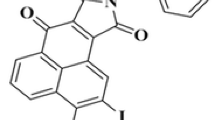Abstract
Pheophorbide a (Pa) is a chlorine-based photosensitizer, and Pa-mediated photodynamic therapy (PDT) reportedly exhibits antitumor activity against various malignancies. The aim of our study was to investigate the therapeutic effect of Pa-mediated PDT on 7,12-dimethylbenz[a]anthracene (DMBA)/12-O-tetradecanoylphorobol-13-acetate (TPA)-induced mouse papillomas. Thirty mice received a topical application of DMBA/TPA on their backs to induce mouse papillomas. One week after two sessions of Pa-mediated PDT, immunohistochemical stains and terminal deoxynucleotidyl transferase dUTP nick end labeling (TUNEL) assay were performed to evaluate the apoptotic effects thereof on the papillomas. Among 63 mouse papillomas treated with Pa-mediated PDT, 17.5 % of the lesions were completely removed 1 week after the first treatment, while 31.7 % disappeared 1 week after the second treatment. Statistical analyses revealed significant differences in therapeutic outcomes for the Pa-mediated PDT group in comparison to a solvent-PDT group and a Pa group. Additionally, a marked downregulation of proliferating cell nuclear antigen expression, as well as upregulation of cleaved caspase 3 and cleaved poly(ADP-ribose) polymerase expression, was noted in the Pa-PDT group, compared to the solvent-PDT group and Pa group. TUNEL assay revealed higher apoptotic cell counts in the Pa-PDT group, although the difference was not statistically significant. Our data demonstrated that Pa-mediated PDT is effective in treating DMBA/TPA-induced mouse papillomas.





Similar content being viewed by others

References
Korbelik M (2006) PDT-associated host response and its role in the therapy outcome. Lasers Surg Med 38(5):500–508
Gollnick SO, Owczarczak B, Maier P (2006) Photodynamic therapy and anti-tumor immunity. Lasers Surg Med 38(5):509–515
Wang H, Li J, Lv T, Tu Q, Huang Z, Wang X (2013) Therapeutic and immune effects of 5-aminolevulinic acid photodynamic therapy on UVB-induced squamous cell carcinomas in hairless mice. Exp Dermatol 22(5):362–363
Gomer CJ, Rucker N, Ferrario A, Wong S (1989) Properties and applications of photodynamic therapy. Radiat Res 120(1):1–18
Pass HI (1993) Photodynamic therapy in oncology: mechanisms and clinical use. J Natl Cancer Inst 85(6):443–456
Dougherty TJ, Gomer CJ, Henderson BW, Jori G, Kessel D, Korbelik M et al (1998) Photodynamic therapy. J Natl Cancer Inst 90(12):889–905
Henderson BW, Dougherty TJ (1992) How does photodynamic therapy work? Photochem Photobiol 55(1):145–157
Braathen LR, Szeimies RM, Basset-Seguin N, Bissonnette R, Foley P, Pariser D et al (2007) Guidelines on the use of photodynamic therapy for nonmelanoma skin cancer: an international consensus. International Society for Photodynamic Therapy in Dermatology, 2005. J Am Acad Dermatol 56(1):125–143
Togsverd-Bo K, Haedersdal M, Wulf HC (2009) Photodynamic therapy for tumors on the eyelid margins. Arch Dermatol 145(8):944–947
Moon S, Bae JY, Son HK, Lee DY, Park G, You H et al (2013) RUNX3 confers sensitivity to pheophorbide a-photodynamic therapy in human oral squamous cell carcinoma cell lines. Lasers Med Sci. doi:10.1007/s10103-013-1350-1
Hajri A, Wack S, Meyer C, Smith MK, Leberquier C, Kedinger M et al (2002) In vitro and in vivo efficacy of photofrin and pheophorbide a, a bacteriochlorin, in photodynamic therapy of colonic cancer cells. Photochem Photobiol 75(2):140–148
Lee WY, Lim DS, Ko SH, Park YJ, Ryu KS, Ahn MY et al (2004) Photoactivation of pheophorbide a induces a mitochondrial-mediated apoptosis in Jurkat leukaemia cells. J Photochem Photobiol B 75(3):119–126
Lim DS, Ko SH, Lee WY (2004) Silkworm-pheophorbide alpha mediated photodynamic therapy against B16F10 pigmented melanoma. J Photochem Photobiol B 74(1):1–6
Tang PM, Chan JY, Au SW, Kong SK, Tsui SK, Waye MM et al (2006) Pheophorbide a, an active compound isolated from Scutellaria barbata, possesses photodynamic activities by inducing apoptosis in human hepatocellular carcinoma. Cancer Biol Ther 5(9):1111–1116
Yoon HE, Oh SH, Kim SA, Yoon JH, Ahn SG (2014) Pheophorbide a-mediated photodynamic therapy induces autophagy and apoptosis via the activation of MAPKs in human skin cancer cells. Oncol Rep 31(1):137–144
Wong BY, Lau BH, Jia TY, Wan CP (1996) Oldenlandia diffusa and Scutellaria barbata augment macrophage oxidative burst and inhibit tumor growth. Cancer Biother Radiopharm 11(1):51–56
Chan JY, Tang PM, Hon PM, Au SW, Tsui SK, Waye MM et al (2006) Pheophorbide a, a major antitumor component purified from Scutellaria barbata, induces apoptosis in human hepatocellular carcinoma cells. Planta Med 72(1):28–33
Moan J, Berg K (1992) Photochemotherapy of cancer: experimental research. Photochem Photobiol 55(6):931–948
Ito K (2011) RUNX3 in oncogenic and anti-oncogenic signaling in gastrointestinal cancers. J Cell Biochem 112(5):1243–1249
Ito K, Liu Q, Salto-Tellez M, Yano T, Tada K, Ida H et al (2005) RUNX3, a novel tumor suppressor, is frequently inactivated in gastric cancer by protein mislocalization. Cancer Res 65(17):7743–7750
Gao F, Huang C, Lin M, Wang Z, Shen J, Zhang H et al (2009) Frequent inactivation of RUNX3 by promoter hypermethylation and protein mislocalization in oral squamous cell carcinomas. J Cancer Res Clin Oncol 135(5):739–747
Chen LF (2012) Tumor suppressor function of RUNX3 in breast cancer. J Cell Biochem 113(5):1470–1477
Acknowledgments
This study was supported by a grant from the Korean Health Technology R&D Project by the Ministry for Health, Welfare & Family Affairs, Republic of Korea (no. A100490)
Author information
Authors and Affiliations
Corresponding author
Additional information
Xianglan Zhang and Eun Joo Choi contributed equally to this work.
Rights and permissions
About this article
Cite this article
Zhang, X., Choi, E.J., Zheng, Z. et al. Apoptotic effect of pheophorbide a-mediated photodynamic therapy on DMBA/TPA-induced mouse papillomas. Lasers Med Sci 30, 51–57 (2015). https://doi.org/10.1007/s10103-014-1615-3
Received:
Accepted:
Published:
Issue Date:
DOI: https://doi.org/10.1007/s10103-014-1615-3



